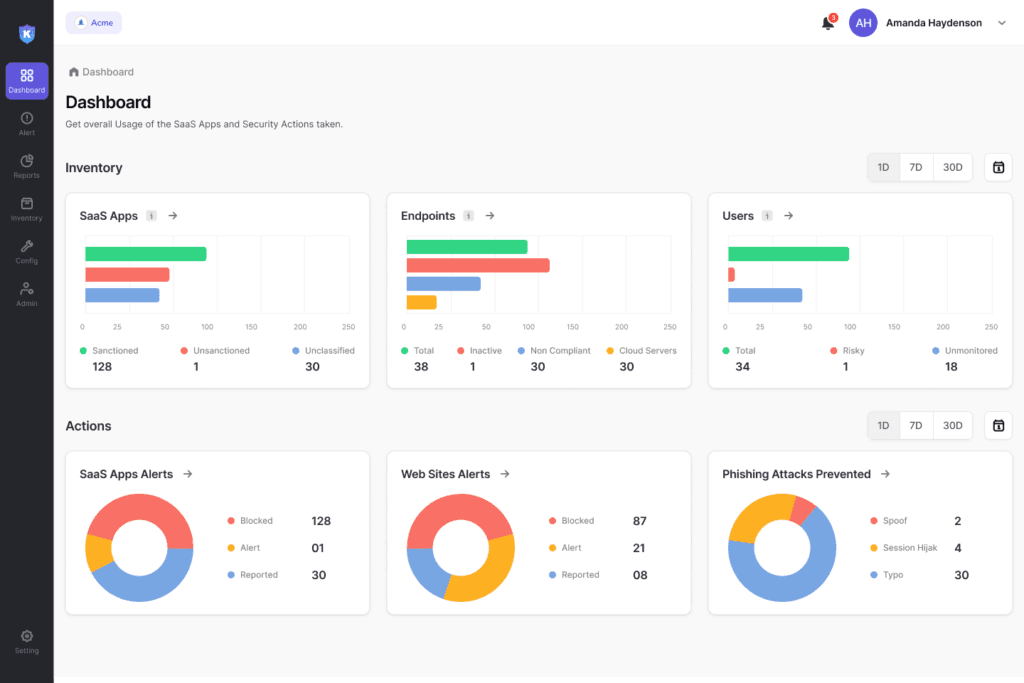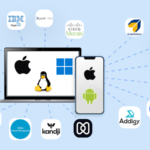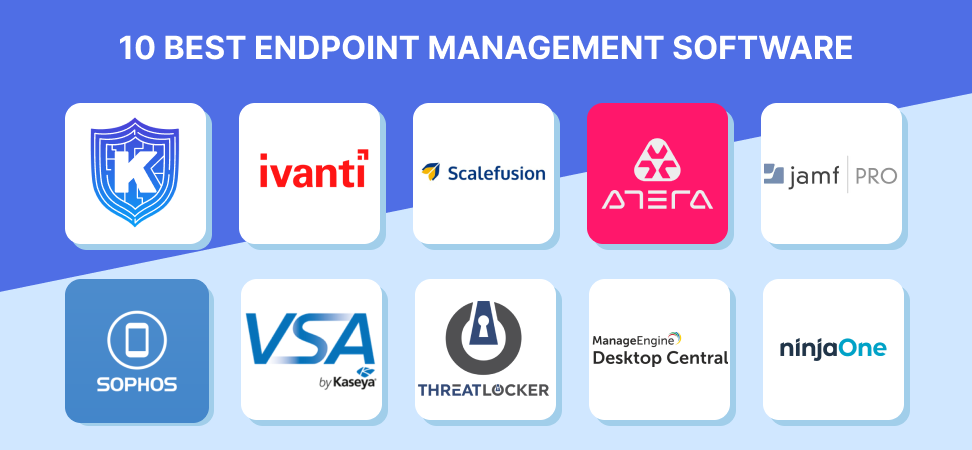Table Of Content
10 Best Endpoint Management Software Solution 2025
-
September 22, 2025
-
Keeping hundreds or thousands of devices secure, compliant, and up to date is no small feat. One missed patch could open a door to attackers. One overlooked policy could lead to a compliance fine. That’s why IT leaders are turning to the best endpoint management software to unify device control, automate patching, and strengthen endpoint security across windows, mac, & linux devices.
With control over endpoints, IT teams can address issues before escalation occurs. This ensures a secure network and a productive workforce. Plus, leveraging a cloud-based endpoint management platform helps streamline operations and boosts efficiency across the organization.
What is Endpoint Management Software?
Endpoint management software is a centralized platform that lets IT teams monitor, manage, and secure all endpoints from one place. These endpoints include:
- Windows, macOS, and Linux laptops and desktops
- iOS and Android smartphones and tablets
- Servers, IoT devices, and virtual machines
Key Benefits of Endpoint Management Solutions
- Centralised control: Manage all endpoints from a single console.
- Stronger security: Apply policies, patch fast, and stop unauthorised access.
- Compliance enforcement: Ensure devices align with standards like HIPAA, GDPR, PCI DSS.
- Automation: Cut repetitive tasks with automated patching, updates, and software installs.
- Scalability: Handle thousands of endpoints, whether remote or on-site.
Must-Have Features of the Best Endpoint Management Software
- Cross-platform support (Windows, macOS, Linux, iOS, Android)
- Patch and vulnerability management
- Mobile Device Management (MDM) integration
- Zero-trust access controls
- Remote desktop and troubleshooting
- Application deployment and controls
- Automation and scripting
- Reporting and analytics dashboards
- Cloud-native scalability
Methodology: How We Chose the Best Endpoint Management Software for 2025
- Comprehensive coverage: Support for desktops, laptops, mobile devices, servers, and virtual machines across Windows, macOS, Linux, iOS, and Android.
- Security and compliance strength: Integrated patching, zero-trust access, data protection, and compliance enforcement with standards like HIPAA, GDPR, and PCI DSS.
- Deployment flexibility: Availability across SaaS, cloud-native, hybrid, and on-premise models to fit different IT environments.
- Automation and scalability: Ability to automate patching, configuration, and reporting at scale for thousands of endpoints.
- Market validation: Recognition by analysts, positive customer adoption trends, and product innovation highlighted in recent G2 reviews and vendor roadmaps.
Top Endpoint Management Software Solutions in 2025
1. Kitecyber Device Shield

Unlike most endpoint management solutions that focus solely on management, Kitecyber emphasizes both device oversight and sensitive data protection. It reduces the need for multiple tools by blending patching, device posture checks, zero-trust access, and data protection. Its unified console tracks data movement across endpoints—ideal for remote work and BYOD environments.
Key features
- Multi-OS UEM: Windows, macOS, Linux, iOS, Android
- Automated patching and vulnerability scanning
- Device posture and conditional access policies
- Remote troubleshooting with lock/wipe options
- Endpoint risk scoring with AI-driven alerts
- SaaS and web app access controls
- Data loss prevention primitives
- Cloud console with multi-tenant supports
Pricing
Enterprise customers can request a custom quote for tailored solutions.
Unlike most endpoint management solutions that rely on a pay-per-endpoint pricing structure, where costs rise with each additional device, Kitecyber bases its pricing on the number of users. There’s also this bundled cost pricing, where all the modules are bundled at a discount.
G2 rating
Kitecyber helped us with IT, security and compliance as a unified solution. It saved us almost 50% in overall cost as compared to our previous solutions, while significantly improving our security and compliance. the builtin device management and IAM integrations, also optimized our onboarding and offboarding workflows."

Venkat Thiruvengadam
CEO, Duplocloud
Best for
2. Ivanti — Ivanti Neurons for Unified Endpoint Management (UEM)

Key features
- Comprehensive asset discovery and inventory
- Enterprise patch management (OS + 3rd-party)
- Policy enforcement & configuration management
- Remote control and scripting automation
- Integration with Ivanti security modules (vulnerability remediation)
- Reporting, compliance dashboards and role-based access
- Scalable cloud and on-prem deployment options
Pricing
- Ivanti typically provides custom quotes; reseller listings show per-license figures for some modules (pricing varies by module and seat). For vendor details and to obtain a current quote contact Ivanti or authorized partners.
G2 rating (most recent)
- Ivanti Neurons for UEM — 4.2 / 5 on G2 (aggregated user reviews).
Best for
- Large enterprises and IT teams that need deep patching, asset management and integration into Ivanti’s automation/security ecosystem.
3. Sophos Mobile (Mobile Control)

Sophos Mobile (Cloud Mobile Control) is Sophos’s mobile device management + mobile threat defense offering integrated into Sophos Central. It focuses on endpoint security consistency across mobile fleets and is often purchased alongside Sophos endpoint protection suites for unified policy management. Sophos emphasizes easy setup, per-user pricing, and integration with Sophos XDR and Intercept X for extended threat telemetry. Real-world customers cite solid MTD features and straightforward admin experience.
Key features
- Mobile Device Management (MDM) for iOS & Android
- Mobile Threat Defense (MTD) integrations
- App allowlisting/blacklisting and application controls
- Secure containerization for corporate data & email
- Remote wipe/lock and geolocation features
- Integration with Sophos Central console and SSO
- Compliance reporting and conditional access controls
Pricing (as of 2025)
- Contact Sophos for specific per-user rates.
G2 rating (most recent)
- Various G2 reviews and comparative listings for Sophos have users report strong support and an overall positive rating on G2.
Best for
- Organizations already using Sophos endpoint/XDR seeking integrated mobile protection managed from a single console.
4. Scalefusion Unified Endpoint Management

Key features
- Multi-OS device management (Android, iOS, Windows, macOS, Linux)
- Kiosk mode & single-app device lockdown
- Remote view / remote control and screen cast
- App management & private app store support
- Location tracking & geofencing for mobile fleets
- Workflow automation and role-based admin controls
- Reporting, compliance and OS update management
Pricing (as of 2025)
- Scalefusion pricing is at $5 / device / month Business plan
G2 rating (most recent)
- Scalefusion averages around 4.6–4.7 / 5 on G2 (high proportion of 5-star reviews; named a G2 leader in MDM categories).
Best for
- Frontline, retail, education and SMBs who need simple, affordable UEM and kiosk/device lockdown functionality.
5. Atera

Key features
- Remote Monitoring & Management (RMM) and endpoint management
- Integrated PSA / ticketing and billing workflows
- Pay-per-technician pricing model (no per-device fees)
- Remote access and unattended support
- Patch management & scripting automation
- Built-in reporting, monitoring and alerts
- Integrations with third-party tools and marketplace add-ons
Pricing (as of 2025)
- Atera uses pay-per-technician pricing — example MSRPs shown on vendor pages: Professional / MSP tiers ~ $129–$169 / technician / month (annual vs monthly billing options; see vendor for current offers).
G2 rating (most recent)
- Atera on G2: ~4.6 / 5 (hundreds of verified reviews, high satisfaction for ease-of-use and value).
Best for
- Small-to-mid MSPs and internal IT teams that prefer predictable per-technician pricing and an all-in-one stack.
6. Jamf Pro

Jamf Pro is the market-leading Apple device management platform, purpose-built for macOS, iOS, iPadOS, tvOS and visionOS. It enables zero-touch deployment, rich configuration profiles, app management, and Apple Business/School Manager integrations. Jamf is known for deep Apple platform feature coverage, extensive scripting/API capabilities, and a strong ecosystem of Apple-centric security and identity integrations. Enterprises with Apple-first fleets use Jamf to achieve comprehensive device lifecycle automation.
Key features
- Zero-touch PreStage device enrollment & DEP integration
- Configuration profiles & smart groups for dynamic policy targeting
- App distribution (App Store, VPP, private apps)
- Security/compliance reporting & remote wipe/lock
- Jamf APIs and extensive automation/scripting
- Integrations with identity providers and security tools
- Device inventory, patching for macOS and iOS management
Pricing (as of 2025)
- Jamf for Mobile / Jamf Pro tiers are often shown around $3.67–$5.75 per device per month depending on product bundle and billing; Jamf’s pricing page lists per-device prices and minimums—contact Jamf for exact enterprise pricing.
G2 rating (most recent)
- Jamf Pro has a strong G2 presence and generally scores highly in Apple device management categories (numerous positive reviews; see Jamf Pro G2 page for exact star average).
Best for
- Organizations with Apple-dominant fleets (education, creative agencies, enterprises requiring deep Apple management).
7. Kaseya (VSA)

Kaseya VSA is a mature RMM and endpoint management platform that provides automation, remote control, patching, and IT orchestration at scale. Kaseya focuses on MSP and enterprise use cases, bundling RMM with broader IT management and security modules. Historically strong on automation and integrations, Kaseya is typically sold as customizable suites—pricing is often via quote. Reviews praise capabilities but also note that the platform has a steeper learning curve than some newer cloud natives.
Key features
- Remote monitoring & unattended remote control
- Automated scripting, job scheduling and orchestration
- Patch management and software deployment
- Asset discovery and IT inventory management
- Role-based access & multi-tenant support for MSPs
- Integration with PSA/backup/security modules
- Reporting, dashboards and compliance tracking
Pricing (as of 2025)
- Kaseya VSA pricing is typically custom / quote-based; public listings and G2 indicate you must contact Kaseya or a reseller for exact pricing.
G2 rating (most recent)
- Kaseya VSA on G2: active reviews and mixed aggregated scores (G2 product pages provide the up-to-date star average — see vendor G2 page).
Best for
- MSPs and enterprises needing an integrated RMM/automation suite with deep orchestration and multi-tenant capabilities.
8. ThreatLocker

ThreatLocker is a zero-trust endpoint protection platform built around application allowlisting, ringfencing, device control, and elevation control. It takes a policy-first, least-privilege approach—allowing admins to allow or deny executables, control privileges, and lock down endpoints to prevent unauthorized code execution. ThreatLocker is often deployed alongside antivirus/EDR for an enforcement layer that prevents unknown binaries from running. Customers praise the concept and outcomes (strong reduction in execution of unwanted software), though initial policy creation requires discipline.
Key features
- Application allowlisting / application control (default deny)
- Ringfencing and process control to limit what apps can do
- Device control (USB/blocking) and storage controls
- Elevation Control (just-in-time admin with approval workflows)
- Policy templates and central management console
- Integrations with SIEM/EDR and reporting for audits
- MSP partner program and multi-tenant management
Pricing (as of 2025)
- ThreatLocker uses tiered/quote pricing; public references indicate starting tiers reported around ~$45–$49 / month for some small configurations but exact costs vary by features and number of endpoints—contact ThreatLocker for a tailored quote.
G2 rating (most recent)
- ThreatLocker company profile on G2 shows an average ~4.8 / 5 from hundreds of reviews (very high satisfaction scores).
Best for
- Organizations that require strict application control and least-privilege enforcement (financial services, healthcare, any org seeking heavy application whitelisting).
9. ManageEngine Desktop Central (Endpoint Central)

ManageEngine Endpoint Central (formerly Desktop Central) is a widely used endpoint management platform geared toward IT teams that need granular patching, software distribution, asset management and remote control across Windows, macOS, Linux, and mobile devices. It has flexible on-prem and cloud deployment models, a comprehensive patch catalogue (3rd-party apps), and cost-competitive licensing that scales by endpoints. Organizations value the breadth of built-in functionality and predictable pricing tiers for common endpoint counts.
Key features
- OS + 850+ third-party application patch management
- Software deployment and configuration management
- Asset discovery, hardware & software inventory
- Remote control & remote troubleshooting
- Power management, device lockdown & endpoint lockdown features
- Compliance reporting, role-based access & templates
- Cloud and on-prem pricing/plans for different endpoint ranges
Pricing (as of 2025)
- ManageEngine Endpoint Central shows an annual price for 50 endpoints ≈ $795 (annual subscription, 1 technician); tiered pricing available for larger counts.
G2 rating (most recent)
- ManageEngine Endpoint Central on G2 — active reviews and ratings
Best for
- SMBs and mid-market IT teams needing a cost-effective, full-featured endpoint management suite with clear pricing for common endpoint bands.
10. NinjaOne Endpoint Management

NinjaOne is a cloud-native RMM and endpoint management platform known for speed, strong patch management, and exceptional usability. It’s widely adopted by MSPs and IT teams that value low-friction onboarding, automation-first workflows, and high customer support scores. NinjaOne invests heavily in usability and has repeatedly ranked highly on G2 reports for RMM, patch management and endpoint categories. Real-world analysis shows strong patch automation, multi-OS support, and a modern cloud console targeted at efficiency.
Key features
- Cloud-native RMM with endpoint inventory and monitoring
- Automated patch management (Windows, Mac, Linux + 3rd-party apps)
- Remote access and scripting automation
- Alerts, reporting, and customizable dashboards
- Integrations with PSA and backup vendors (native connectors)
- Multi-tenant and role-based admin controls for MSPs
- Free onboarding services and high-touch customer support
Pricing (as of 2025)
- NinjaOne publishes tiered per-device guidance: pricing ranges ~ $1.50 / device / month (very large volumes) up to ~$3.75 / device / month at small volumes; exact price depends on endpoint count and modules.
G2 rating (most recent)
- NinjaOne has a large G2 footprint and is often rated ~4.7 / 5 (leader in many G2 categories and top rankings across RMM/endpoint/patch management). G2+1
Best for
- MSPs and medium/large IT teams that need a cloud-native, easy-to-use platform with best-in-class patching and strong support.
Get AI-Powered Endpoint Management & Security with Kitecyber Device Shield
Kitecyber enhances IT efficiency with features like remote wipe, remote lock, and endpoint configuration, empowering teams to secure and manage devices effortlessly. If you’re ready to experience Kitecyber Device Shield for yourself, reach out to our sales team for a custom quote or demo today—no credit card required.

Ajay Gulati
Ajay Gulati is a passionate entrepreneur focused on bringing innovative products to market that solve real-world problems with high impact. He is highly skilled in building and leading effective software development teams, driving success through strong leadership and technical expertise. With deep knowledge across multiple domains, including virtualization, networking, storage, cloud environments, and on-premises systems, he excels in product development and troubleshooting. His experience spans global development environments, working across multiple geographies. As the co-founder of Kitecyber, he is dedicated to advancing AI-driven security solutions.










